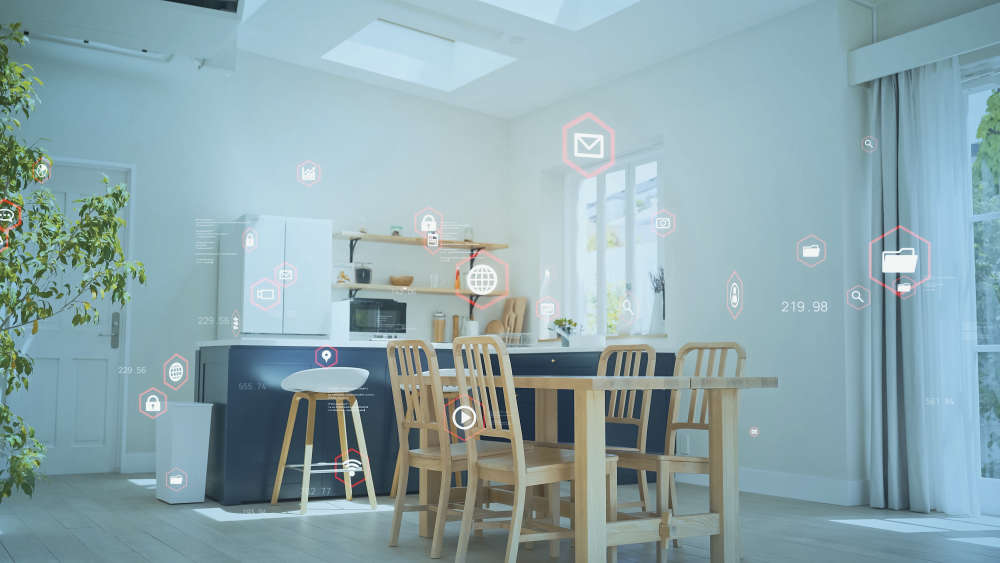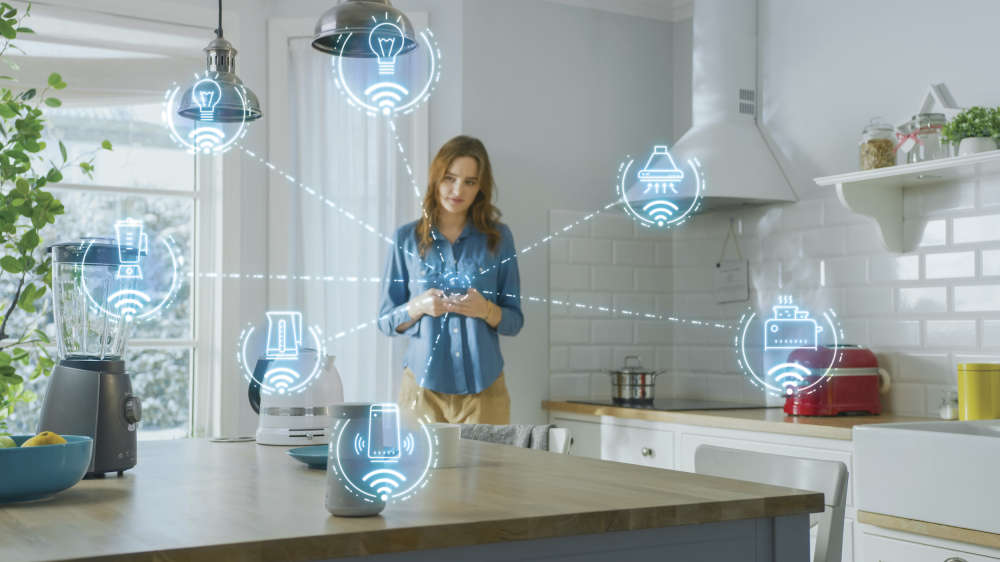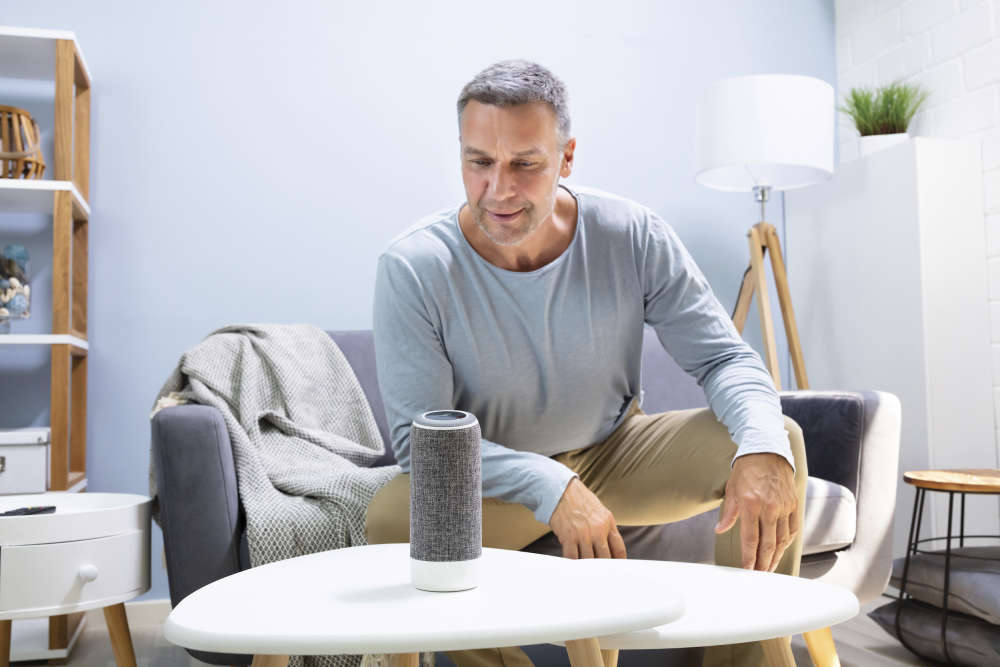
It’s time to start thinking smart about our homes. Tailor your home to your needs and help to combat the climate crisis as well; Sara Whatley gives you some suggestions how
The modern smart homes don’t just look smart, they act smart too. The phrase ‘smart home’ refers to a home that is using the latest technology to improve it and in some cases, make it more environmentally friendly as well. We are going to look at both automated smart homes that can be remotely controlled through our smart phones or tablets, and also smart homes which use technology to help protect the environment, a very urgent issue which we all need to take into account.

CONNECTED HOMES
Do you ever worry that you have left the oven on, forgotten to record your favourite programme, or realised you’re on your way home early and want it to be toasty warm when you get through the front door? No problem with an automated smart home. All electronics in your home can be connected to your devices (smart phone or tablet) through a home network and at your command you can control them remotely. The ‘Internet Of Things’ (IOT) is the phrase you need to know here, which describes physical objects and products that are embedded with sensors, chips or other technologies that can all speak to each other and exchange data through digital networks.
Common things people choose to connect to their network are their home security systems, lighting, thermostat regulation and home entertainment systems, but really the list of things you can connect is endless, provided it holds the correct technology.
Once just a plaything for the super wealthy or tech-savvy, automated smart homes are now more widely available and are much more consumer friendly. Choosing a system to connect all your devices to is the first step, then utilising it how you see fit. Think about your existing routine, then think about what can be automated from that. Doors that unlock as you approach? Rooms that light up as you enter and go dark as you leave? Music and entertainment that follows you around your home? It’s all possible and designed to simplify and streamline your life.
There may be an initial outlay of expense in setting up an automated smart home but in the long run it could help cut down your bills with some energy efficiency savings. Lights turning off, heating tailored to your needs and gadgets that put themselves to sleep or into power saving mode will all help cut costs; all welcome news indeed with the current rising cost of energy.
Other benefits of setting up a home with this technology include helping elderly, disabled or vulnerable people. For example, cookers can be programmed to switch off when not attended, bath water shut off if overflowing, a reminder to take medications could be set up, even an alert system sent to the hospital if the resident falls.
Some people will be put off by all the fiddly technology and if this sort of home will cost you more in time and energy then it’s probably not for you. But if you do want to give it a go then start small and build up.

SMART HOME PRODUCTS
The other type of smart home is not the automated kind, but one filled with eco friendly smart home products, which use the latest technology to help protect the environment and improve our homes in one fell swoop.
These homes are smart in terms of producing less pollution, using less of our planet’s resources and consequently saving us more money. Again, brilliant news to help keep the cost of those rising bills down.
Although one must keep in mind the initial cost of investing and improving our homes in this way, once it is done the outlay should be recouped within a few years. And if it’s a new build or refurbishment then the potential extra cost of incorporating these technologies will only be a small percentage on top of the existing cost.
There are large improvements that can be made, such as installing a geothermal or ground source heat pump. These types of heating systems take advantage of the earth’s natural ability to store heat in the ground. In winter the earth can be used as a heat source and in summer as a heat sink. This is a clean way to heat buildings and produces no carbon emissions. It is also very safe, easy to maintain, space saving and although there is a bigger initial cost than combustion based heating systems, in the long run they should save money.
Another large upgrade is to consider going green – literally green! A green or living roof is a great way to insulate our homes, again reducing energy costs, and they can help to manage large rain downfalls too, retaining the water and absorbing it into the plants. Other benefits include cleaner air and a unique and beautiful look for the building.
There are also many smaller home improvements to be made utilising green technology. Eco friendly paint is one, or how about smart eco flooring options? These include cork, bamboo, reclaimed rubber made from tyres or for those that prefer something softer underfoot how about an eco friendly wool carpet or one made from other natural fibres such as jute, sisal and coir. P.E.T Polyester carpets are also sustainable and durable, and made from recycled plastic cartons and bottles.
Even if it’s just one small thing you upgrade around your home to adopt a greener living space, give LED light bulbs a go. More efficient, longer lasting, versatile and durable, and only a little more expensive than traditional light bulbs, it’s an investment worth making. After all, we are investing not only in our homes, but in the future of our planet too.


 Blooming Times: Happy Faces
Blooming Times: Happy Faces
 Blooming Times: Winter Sparklers
Blooming Times: Winter Sparklers
 Homes Extra: Restore, Repair, Recycle
Homes Extra: Restore, Repair, Recycle
 Home Style: A Scandi Winter's Tale
Home Style: A Scandi Winter's Tale
 Blooming Times: Winter Wonders
Blooming Times: Winter Wonders
 Home Style: Bold, Brave & Beautiful
Home Style: Bold, Brave & Beautiful
 Blooming Times: The Answer Lies in the Soil
Blooming Times: The Answer Lies in the Soil
 Blooming Times: Heavenly Hyacinths
Blooming Times: Heavenly Hyacinths
 Legendary Builds with Phoenix Construction Services
Legendary Builds with Phoenix Construction Services
 Blooming Times: Know Your Enemy
Blooming Times: Know Your Enemy
 Bespoke Dreams from Eridge Green Kitchens
Bespoke Dreams from Eridge Green Kitchens
 10 Hot Years: iFit Fires & Flues
10 Hot Years: iFit Fires & Flues
 Home Style: Bold Type
Home Style: Bold Type
 Blooming Times: The Sky's the Limit
Blooming Times: The Sky's the Limit
 Home Style: A Better Way of Life
Home Style: A Better Way of Life
 Homes Extra: Shed Space
Homes Extra: Shed Space
 Blooming Times: Top of the Pots
Blooming Times: Top of the Pots
 Kids Zone: Get the Kids Growing
Kids Zone: Get the Kids Growing
 Home Style: Pastures New
Home Style: Pastures New
 Homes Extra: Let There Be Light
Homes Extra: Let There Be Light